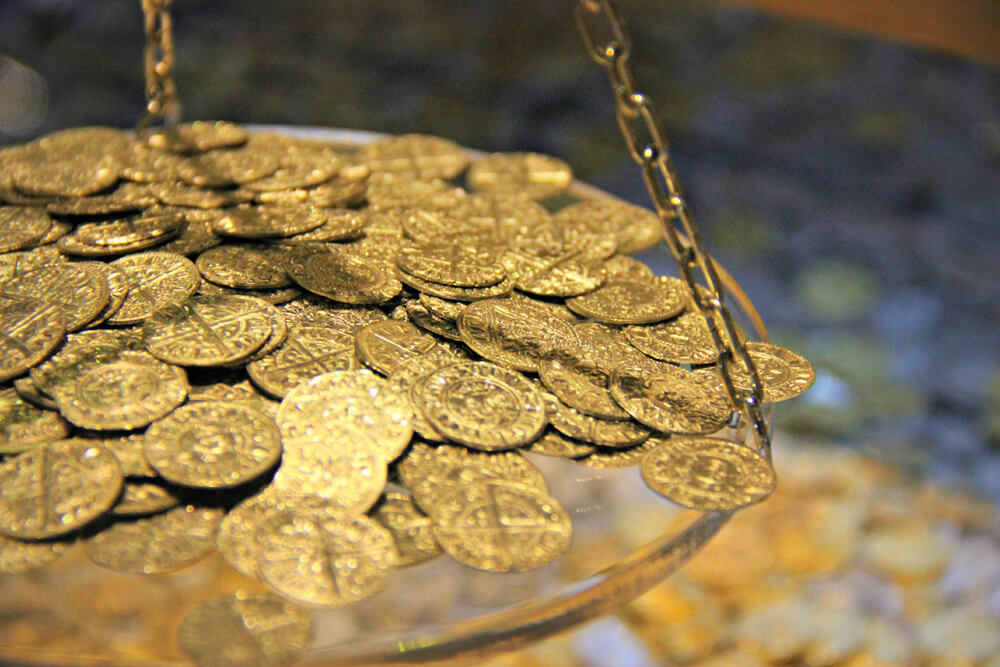
What are Mexican Gold Coins? How Much Are They Worth?
When most people think of gold coins, bullion coins such as the American Gold Eagle, Canadian Gold Maple Leaf, Vienna Philharmonic, Krugerrand gold coin, and even the Chinese Gold Panda come to their minds first. Mexican coins are usually an afterthought or not on the radar at all.
Mexico is a land of great food, splendid beaches, rich culture and tradition, and a friendly populace. But many forget that the country is also home to large gold mining operations and deposits—not to mention, the glorious Mexican Mint.

The Mexican peso may not be among the most trade-friendly currencies in the world, but the gold versions of those coins have their following. We won't judge you if you have not heard much about Mexican gold coins before. But now that you’ve stumbled upon their names here, we encourage you to continue reading and learn more, particularly if you’re in the bullion coin investment or coin collection space.
We’ll go over the following for a detailed deep dive:
- Getting to know the Mexican Mint’s past and present
- Learning more about popular Mexican gold coins
- The possibilities of adding Mexican gold pesos and other coins to a portfolio, etc.
The most profitable gold coin investors dabble in different bullion coins and bars. If you aspire to be a savvy gold bullion investor too, keep reading.
Table of Contents
The Mexican Mint: One of the oldest in the Americas
The Mexican national mint, called “La Casa de Moneda de Mexico” in Spanish, is the oldest and one of the longest-running mints in the world. Founded in 1535, the Mexican Mint started its journey by producing silver coins and later branched out to other metals, such as gold.
The Mint has been making coins before Mexico’s independence. Antonio de Mendoza, the Spanish viceroy who set up the facility. That was when Christopher Columbus had freshly sighted the Americas and, with subsequent voyages, ventured further south to South and Central America.
Entrepreneurs rented the Mexican Mint multiple times during the 17th and 18th centuries. But the government fully controlled the minting process. The minting workshops were transferred a few times, but the new locations were always close to the vice-royal palace.
In 1778, the Ministry of Finance assumed complete authority over the Mint. The Mint started using screw presses to strike coins instead of hammering the metal strips by hand. The minted coins, as a result, were much higher quality than before.
During the Mexican War of Independence, the Mexico City workshop dwindled, leaving the central government unable to manage supply. Distributing coins all over the country, as a result, was no longer feasible. To remedy things, the Mint was split into various workshops throughout Mexico, including one in San Luis Potosi, known for its silver reserves since 1592.
During the 19th century, Mexico needed many more coins in circulation, which the existing mints could not fully produce. For a brief period, the minting was outsourced to foreign mints, including the Philadelphia Mint.
The state implemented new minting technology in 1905 to stop delegation to mints outside Mexico. Electrical equipment replaced the previously used steam engines. Mexico took a few years to go completely autonomous since workers had to be trained to use the new machines efficiently and at full capacity.
When the Bank of Mexico (Banco de Mexico in Spanish) was founded in 1925, it took complete control of the Mexican Mint’s operations and held on to it until 1986. Between 1925 and 1986, the central bank assumed exclusive authority to print banknotes and mint coins. The goal was to seal the gaps in Mexico’s broken banking infrastructure then.
Currently, the Bank of Mexico is no more hands-on with the mint’s operations. It keeps administrative control, distributes the coins, and remains the mint’s biggest client. The transition changed how Mexican coins and currency were made, with newer Mexican pesos and commemorative coins entering circulation.
Read more: Krugerrand Gold Coin
The modern Mexican Mint is no longer linked with the Ministry of Finance—that has been the case since 1986. The Mint’s operations were also moved from Mexico City to San Luis Potosi in 1992, which has been the Mint’s primary location ever since. The mint is now more of an industrial organization competing with other mints worldwide, making other national currencies.
Below are the three most popular Mexican bullion coins to know about.
The Mexican Peso

Peso is the official currency of Mexico. Owing to the ubiquity and national status, it is only natural for the Mexican mint to make gold versions of the money.
Peso gold coins are more widely available than other Mexican gold coins and trade at a lower price point. The affordable price is because gold peso coins start sized very small. The 1945 gold dos pesos (two pesos) has less than two grams of gold (1.37 gm or .0482 oz). The coins are 90% gold and 10% copper.
Below listed are all the gold Mexican pesos, their gold content, and their current market prices approximately:
- 2 pesos (0.0482 t oz/1.49 gm)/ $120
- 2.5 pesos (0.0602 t oz/1.87 gm)/ $147
- 5 pesos (0.1205 t oz/3.74 gm)/ $261
- 10 pesos (0.2411 t oz/7.50 gm)/ $495
- 20 pesos (0.48227 t oz/15 gm)/ $962
- 50 pesos (1.206 t oz/37.5 gm)/ $2,525
For the most current prices, visit Apmex, JM Bullion, etc.
Design
The design of different Mexican gold pesos varies. The 50-peso coin, for instance, has the Angel of Independence image on the front side and the coat of arms of Mexico symbol on its back. The other currencies have the perched eagle on their rears, but the front doesn’t bear the angel, but the coin’s face value, minting year, and other intricacies.
Production Numbers
The dos pesos coin was first made in 1919, with approximately 1,670,000 coins minted. The currency continued to be in production until 1920. Minting recommenced in 1944 and continued until 1948. However, you can find no 1948-dated dos pesos. Between 1951 and 1972, more than 4,590,493 dos pesos were struck dated 1945. Additional 260,000 pieces were minted between 2000 and 2009, with the dates marked 1945.
The production numbers for other denomination pesos are pretty similar. Not to mention, all Mexican gold pesos issued between 1949 and 1972 have their manufacturing dates marked 1947. The 50-peso gold coin is called the Centenario.
Centenario
Initially issued in 1921 to memorialize Mexico’s 100th independence anniversary from Spain, the 50-peso gold Centenario is among the first few bullion gold coins (Mexican or otherwise) to be issued globally.
The 21.6-karat gold alloy is 90% gold and 10% copper. The gold content is 37.5 grams (1.3 oz.). The subtle yet distinct reddish-golden hue is due to the copper. The fact that the Centenarios never were in general circulation as currency ensured they remained in impeccable condition always, which boosted their value significantly. You can check the coin’s current worth using the above links.
Design
The Centenario design symbolizes the coin’s intended purpose. The obverse has the Angel of Independence imagery, signifying Mexican independence, with a wreath in her right hand. Her left arm holds broken chains, indicating freedom from Spanish colonial rule. The year 1921 is when the coin was minted and also the 100th anniversary of Mexican independence. The rim bears the “Independencia y Libertad” inscription, which means “independence and freedom.”
The back side has the coat of arms of Mexico imagery comprising the Mexican eagle perching on a cactus plant and latching onto a snake by its beak, with laurel and oak leaves encircling the image at the bottom half. The top half bears the text “Estados Unidos Mexicanos,” which means “United Mexican States.”
Mintage Numbers
In 1921, approximately 180,000 Centenarios were minted. The coins were produced until 1931. 137,000 of them were made in that year. The coin’s second run was from 1943 to 1947. The coin’s mintage was very low at 89,000 coins in 1943. The “50 pesos” denomination resurfaced on the coin in 1944. In 1946, the Mexican Mint made 1,588,000 Centenarios. The next year, in 1947, it made close to 309,000.
Centenarios were continuously produced from 1949 to 2009, with breaks in between. But all the coins minted during the period have their manufacturing year marked 1947. Between 1949 and 1972, close to 3,975,654 coins were made. In 1996, an additional 7,954,777 coins were produced, dated 1947. Between 2000 and 2009, another 302,000 Centenarios were issued, again with the 1947 date inscription.
Libertad
First minted in 1981, the Libertad gold coin has zero face value. Very few official gold bullion coins are minted with no denomination, making the gold Libertad rare and unique. The Mexican government assigns a value to the currency based on the purity and weight information etched on it.
The Libertad comes in gold and silver, with a very high purity level compared to other Mexican gold coins. The first Mexican gold Libertad was made in 1981. Silver Libertads started to come out a year later, in 1982. There are five different weight/size variants of gold Libertad coins—the smallest being 0.048 t oz (1.5 gm) and the heaviest weighing in at 1 t oz (31.1 gm).
Design
The original set of Mexican Libertad coins (minted between 1981 and 1999) had a design identical to the Centenario—the Angel of Independence image on the obverse side and the eagle with the rattle snack on the back. The texts and numbers denoting the coin’s value and year of minting were different.
The Libertads released after 2000 had a change of design, however. The angel was no longer looking straight on but slightly to her right, and her right arm stretched out, holding the wreath. The engravings above the angel’s head were also shed in the new design to make room for coin-specific information (year of minting, metal content, purity, and face value). However, the volcanic mountain peaks in the background stayed.
The rear side had a slightly more drastic design overhaul. The coat of arms imagery was more petite and positioned right in the center with ten other variations of the iconic symbol surrounding the image in the center. The center coat of arms depiction has the text “Estados Unidos Mexicanos” circling its top half.
Production Numbers
The initial production of Libertad coins was limited. It took nearly a decade for the national mint to make a lot more Mexican gold Libertads. With the Libertad, the Mint’s goal was to create a Mexican coin that would compete with more popular bullion coins such as the Canadian Maple Leaf, American Gold Eagle, and Krugerrand coins. In 1981, the Libertad came in 1 t oz. (31.1 gm), ½ oz. (15.5 gm), and ¼ oz. (7.78 gm) weight distributions.
The Mexican Mint produced the gold Libertads as a standard coin and in “reverse proof” and “proof” avatars. The proof coin has frosted angel imagery with a glossy background. The reverse proof coin has a frosted background and a polished angel.
The Mexican Mint first issued a proof version of the half-ounce Libertad in 1989 and stopped production within a year. In 2004, the coin reappeared with the same design but in a quarter-ounce form. New proof versions of the coin are now minted every year.
The reverse proof gold Libertad and proof gold Libertad were minted in fewer quantities, making them both highly desirable among coin collectors. The reverse proof gold Libertad is particularly very high-value.
Prices
Mexican Libertad gold coin prices vary depending on their condition, sizes or gold content, proof or non-proof versions, etc. A 0.05 t oz. coin will cost around $245. A 0.1 t oz. coin, on the other hand, will set you back $435 approximately. The proof variant of the same 0.1 t oz. coin will cost around $631.
Quite clearly, the price of the gold Libertad and other gold coins mentioned here can span a range based on their historicity and physical condition.
How Collectable are Mexican Gold Coins?
Based on their physical condition and historicity, Mexican gold coins could sell for a few hundred dollars or assume cult-like status. The rarer and more pristine the coin’s condition, the higher the coin’s value. The gold Centenario coin, for instance, would command a lot higher price if it’s the one made in 1921 or 1947.
But because discerning a Mexican gold coin that was struck in 1947 or 1945 from one that was not but bears the year signage can be complex. Most Mexican gold coin dealers cannot confirm the same and, therefore, put it in writing in product descriptions that the coin buyers receive may not bear the same year of make as shown in the product image.
The other question is, “Should you buy Mexican gold coins?” As stated earlier, Mexican gold pesos or other gold coins minted from the country do not enjoy global status like some other more popular bullion coins. It’s, therefore, safe to assume these coins are underrated, undervalued, and likely worth a long-term buy.
We don’t expect Mexican peso gold coins to shoot up in value anytime soon, but their trajectory is likely upward. And even if they don’t rally ahead, the gold content will be worth some significant change anyway.
Read more: The Best 1 oz Gold Coin to Buy
Conclusion
Mexican gold coins are solid investment pieces like any other gold coin. They may not be the most popular, but because they are made of gold, the coins will be worth something till gold remains valuable. Therefore, go ahead and buy some Mexican gold coins.
If you’re particular about purity, look at the Libertads. If you want something with more sentimental value and are okay with lesser gold content, the 50-peso gold coin is a solid option.
If, on the other hand, you’re unsure but would like to dabble with Mexican bullion or want a taste of it at a relatively low price, the dos pesos coin is a great coin to get started with.
FAQs
Are Mexican gold peso coins gold IRA-friendly?
No, you cannot add Mexican gold coins to a gold IRA as they do not meet the necessary fineness or purity requirements for inclusion in an IRA. Most gold peso coins are only 90% gold. Gold IRAs require the bullion coins or bars to be at least 99.5% pure.
Gold and silver Mexican Libertad coins can be added to a precious metals IRA as they are 99.9% pure, meeting the purity requirement for a gold or silver bullion coin to be eligible for a self-directed IRA.


